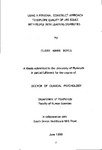USING A PERSONAL CONSTRUCT APPROACH TO EXPLORE QUAUTY OF LIFE ISSUES WITH PEOPLE WITH LEARNING DISABILTTIES
| dc.contributor.author | BOYES, CLAIRE MARIE | |
| dc.contributor.other | School of Psychology | en_US |
| dc.date.accessioned | 2013-09-11T12:02:36Z | |
| dc.date.available | 2013-09-11T12:02:36Z | |
| dc.date.issued | 1999 | |
| dc.identifier | NOT AVAILABLE | en_US |
| dc.identifier.uri | http://hdl.handle.net/10026.1/1665 | |
| dc.description.abstract |
While an agreed definition of quality of life rennains elusive, research into the quality of life of people with learning disabilities has developed significantly. Following a discussion of this work, the author argues that these assessment processes should be refocused towards the views of people with learning disabilities themselves, particularly given the idiosyncratic nature of the quality of life issue. This study explores the use of the Personal Construct Psychology (PCP) approach in assessing quality of life with people with learning disabilities.'Ideal'elements were introduced into repertory grid production to measure differences between ideal and actual situations. The results indicate the success of this approach. Significant associations were found between ability level and the amount of elements and constructs generated. No significant association between ability level and the proportion of concrete (vs. abstract) information was found. Explorations of the approach's clinical reliability and clinical validity were inconclusive. In summary, the study provides further support for the use of PCP techniques with people with learning disabilities and demonstrates its successful application to quality of life issues. Although further research is needed into the scope of its application, it is concluded that the PCP approach is an appropriate way of undertaking quality of life assessments with people with learning disabilities. | en_US |
| dc.description.sponsorship | South Devon Healthcare NHS Trust | en_US |
| dc.language.iso | en | en_US |
| dc.publisher | University of Plymouth | en_US |
| dc.title | USING A PERSONAL CONSTRUCT APPROACH TO EXPLORE QUAUTY OF LIFE ISSUES WITH PEOPLE WITH LEARNING DISABILTTIES | en_US |
| dc.type | Thesis | |
| plymouth.version | Full version | en_US |
| dc.identifier.doi | http://dx.doi.org/10.24382/1584 | |
| dc.identifier.doi | http://dx.doi.org/10.24382/1584 |
Files in this item
This item appears in the following Collection(s)
-
01 Research Theses Main Collection
Research Theses Main


